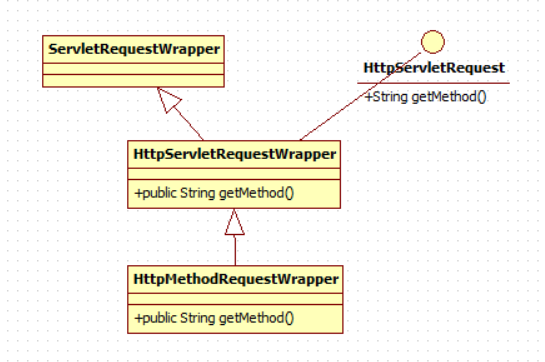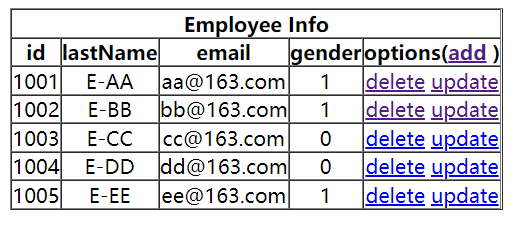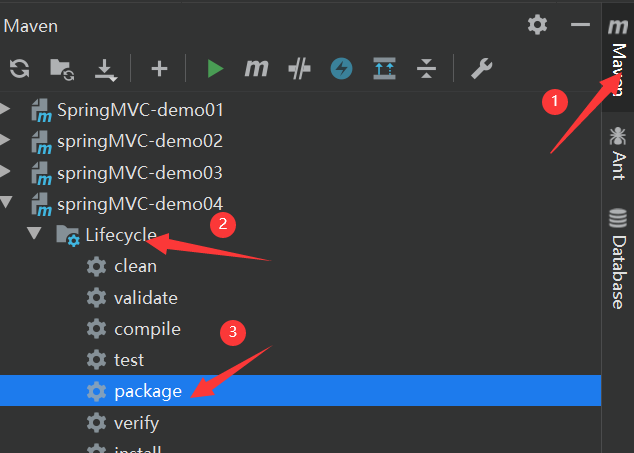【SpringMVC】RESTFul简介以及案例实现
RESTful
概念
REST:Representational State Transfer,表现层资源状态转移。
资源
资源是一种看待服务器的方式,即,将服务器看作是由很多离散的资源组成。每个资源是服务器上一个可命名的抽象概念。因为资源是一个抽象的概念,所以它不仅仅能代表服务器文件系统中的一个文件、数据库中的一张表等等具体的东西,可以将资源设计的要多抽象有多抽象,只要想象力允许而且客户端应用开发者能够理解。与面向对象设计类似,资源是以名词为核心来组织的,首先关注的是名词。一个资源可以由一个或多个URI来标识。URI既是资源的名称,也是资源在Web上的地址。对某个资源感兴趣的客户端应用,可以通过资源的URI与其进行交互。资源的表述
资源的表述是一段对于资源在某个特定时刻的状态的描述。可以在客户端-服务器端之间转移(交换)。资源的表述可以有多种格式,例如HTML/XML/JSON/纯文本/图片/视频/音频等等。资源的表述格式可以通过协商机制来确定。请求-响应方向的表述通常使用不同的格式。状态转移
状态转移说的是:在客户端和服务器端之间转移(transfer)代表资源状态的表述。通过转移和操作资源的表述,来间接实现操作资源的目的。
RESTFul的实现
具体说,就是 HTTP 协议里面,四个表示操作方式的动词:GET、POST、PUT、DELETE。
它们分别对应四种基本操作:GET 用来获取资源,POST 用来新建资源,PUT 用来更新资源,DELETE 用来删除资源。
REST 风格提倡 URL 地址使用统一的风格设计,从前到后各个单词使用斜杠分开,不使用问号键值对方式携带请求参数,而是将要发送给服务器的数据作为 URL 地址的一部分,以保证整体风格的一致性。
| 操作 | 传统方式 | REST风格 |
|---|---|---|
| 查询操作 | getUserById?id=1 | user/1-->get请求方式 |
| 保存操作 | saveUser | user-->post请求方式 |
| 删除操作 | deleteUser?id=1 | user/1-->delete请求方式 |
| 更新操作 | updateUser | user-->put请求方式 |
如何处理PUT和DELETE请求
由于浏览器只支持发送get和post方式的请求,那么该如何发送put和delete请求呢?
SpringMVC 提供了 HiddenHttpMethodFilter 帮助我们将 POST 请求转换为 DELETE 或 PUT 请求
HiddenHttpMethodFilter源码
public class HiddenHttpMethodFilter extends OncePerRequestFilter {
private static final List<String> ALLOWED_METHODS;
public static final String DEFAULT_METHOD_PARAM = "_method";
private String methodParam = "_method";
public HiddenHttpMethodFilter() {
}
public void setMethodParam(String methodParam) {
Assert.hasText(methodParam, "'methodParam' must not be empty");
this.methodParam = methodParam;
}
protected void doFilterInternal(HttpServletRequest request, HttpServletResponse response, FilterChain filterChain) throws ServletException, IOException {
HttpServletRequest requestToUse = request;
if ("POST".equals(request.getMethod()) && request.getAttribute("javax.servlet.error.exception") == null) {
String paramValue = request.getParameter(this.methodParam);
if (StringUtils.hasLength(paramValue)) {
String method = paramValue.toUpperCase(Locale.ENGLISH);
if (ALLOWED_METHODS.contains(method)) {
requestToUse = new HiddenHttpMethodFilter.HttpMethodRequestWrapper(request, method);
}
}
}
filterChain.doFilter((ServletRequest)requestToUse, response);
}
static {
ALLOWED_METHODS = Collections.unmodifiableList(Arrays.asList(HttpMethod.PUT.name(), HttpMethod.DELETE.name(), HttpMethod.PATCH.name()));
}
private static class HttpMethodRequestWrapper extends HttpServletRequestWrapper {
private final String method;
public HttpMethodRequestWrapper(HttpServletRequest request, String method) {
super(request);
this.method = method;
}
public String getMethod() {
return this.method;
}
}
}
源码解析
private static final List<String> ALLOWED_METHODS;
static {
ALLOWED_METHODS = Collections.unmodifiableList(Arrays.asList(HttpMethod.PUT.name(), HttpMethod.DELETE.name(), HttpMethod.PATCH.name()));
}
ALLOWED_METHODS是一个静态常量类型的字符串List,使用静态代码块在类加载时对其进行初始化,存储的内容为[PUT,DELETE,PATCH]。HttpMethod是一个枚举类型。
public static final String DEFAULT_METHOD_PARAM = "_method";
private String methodParam = "_method";
HiddenHttpMethodFilter类的静态常量“默认方法参数”是"_method",给定私有方法参数也是"_method"。
public void setMethodParam(String methodParam) {
Assert.hasText(methodParam, "'methodParam' must not be empty");
this.methodParam = methodParam;
}
提供了一个方法用于修改类内默认的方法参数并且断言形参不能为空。
protected void doFilterInternal(HttpServletRequest request, HttpServletResponse response, FilterChain filterChain) throws ServletException, IOException {
HttpServletRequest requestToUse = request;
if ("POST".equals(request.getMethod()) && request.getAttribute("javax.servlet.error.exception") == null) {
String paramValue = request.getParameter(this.methodParam);
if (StringUtils.hasLength(paramValue)) {
String method = paramValue.toUpperCase(Locale.ENGLISH);
if (ALLOWED_METHODS.contains(method)) {
requestToUse = new HiddenHttpMethodFilter.HttpMethodRequestWrapper(request, method);
}
}
}
filterChain.doFilter((ServletRequest)requestToUse, response);
}
这个方法是该类中实现过滤器功能的主要方法,是重点。第一个if判断要求请求的方式必须是POST否则方法不会执行。paramValue获取请求参数this.methodParam的值,这里需要注意当前请求必须传输请求参数_method。将paramValue统一为大写字母之后,判断如果ALLOWED_METHODS包含paramValue的请求方式,就把该请求方式和request作为参数创建HttpMethodRequestWrapper静态内部类,并把返回值赋给requestToUse,过滤器放行的时候原本的request已经被替换成了requestToUse这一新的,以paramValue为请求方式的请求。
下面看一下HttpMethodRequestWrapper静态内部类
private static class HttpMethodRequestWrapper extends HttpServletRequestWrapper {
private final String method;
public HttpMethodRequestWrapper(HttpServletRequest request, String method) {
super(request);
this.method = method;
}
public String getMethod() {
return this.method;
}
}
HttpMethodRequestWrapper类的继承关系如下:

HttpMethodRequestWrapper类重写了getMethod()方法,偷梁换柱,实现了对请求方式的修改,可以使getMethod()方法返回PUT或DELETE。
由于HttpMethodRequestWrapper实现了HttpServletRequest接口,所以利用多态,可以在上面讲的doFilterInternal方法中,使得父类引用HttpServletRequest指向该类,在放行时把原来的request替换,也就实现了,服务器发送PUT和DELETE的需求。
使用方法
<form action="/rest/12" method="post">
<input type="hidden" name="_method" value="DELETE">
<input type="submit" value="delete">
</form>
<form action="/rest/12" method="post">
<input type="hidden" name="_method" value="PUT">
<input type="submit" value="put">
</form>
<form action="/rest/12" method="post">
<input type="submit" value="post">
</form>
<form action="/rest/12" method="get">
<input type="submit" value="get">
</form>
控制器
@RequestMapping(value = "/rest/{id}",method = RequestMethod.DELETE)
public String testrestDELETE(@PathVariable int id, Model model){
model.addAttribute("msg","delete请求"+id);
return "SUCCESS";
}
@RequestMapping(value = "/rest/{id}",method = RequestMethod.PUT)
public String testrestPUT(@PathVariable int id,Model model){
model.addAttribute("msg","put请求"+id);
return "SUCCESS";
}
@RequestMapping(value = "/rest/{id}",method = RequestMethod.POST)
public String testrestPOST(@PathVariable int id,Model model){
model.addAttribute("msg","post请求"+id);
return "SUCCESS";
}
@RequestMapping(value = "/rest/{id}",method = RequestMethod.GET)
public String testrestDELETE(@PathVariable int id, ModelMap modelMap){
modelMap.addAttribute("msg","get请求"+id);
return "SUCCESS";
}
RESTFul案例
案例需求
传统 CRUD 小项目,实现对员工信息的增删改查。

add:添加员工
delete:删除员工
update:更新员工
项目结构
├─springMVC-demo04
│ ├─src
│ │ ├─main
│ │ │ ├─java
│ │ │ │ └─com
│ │ │ │ └─springmvc
│ │ │ │ └─gonghr
│ │ │ │ ├─bean
│ │ │ │ ├─controller
│ │ │ │ └─dao
│ │ │ ├─resources
│ │ │ └─webapp
│ │ │ ├─static
│ │ │ │ └─js
│ │ │ └─WEB-INF
│ │ │ └─templates
│ │ └─test
│ │ └─java
│ └─target
│ ├─classes
│ ├─generated-sources
│ ├─maven-archiver
│ ├─maven-status
│ └─springMVC-demo04-1.0-SNAPSHOT
└─src
SpringMVC 框架搭建
准备工作
准备实体类
/bean/Employee.java
public class Employee {
private Integer id;
private String lastName;
private String email;
//1 male, 0 female
private Integer gender;
public Integer getId() {
return id;
}
public void setId(Integer id) {
this.id = id;
}
public String getLastName() {
return lastName;
}
public void setLastName(String lastName) {
this.lastName = lastName;
}
public String getEmail() {
return email;
}
public void setEmail(String email) {
this.email = email;
}
public Integer getGender() {
return gender;
}
public void setGender(Integer gender) {
this.gender = gender;
}
public Employee(Integer id, String lastName, String email, Integer gender) {
super();
this.id = id;
this.lastName = lastName;
this.email = email;
this.gender = gender;
}
public Employee() {
}
}
准备dao模拟数据
/dao/EmployeeDao
@Repository
public class EmployeeDao {
private static Map<Integer, Employee> employees = null;
static{
employees = new HashMap<Integer, Employee>();
employees.put(1001, new Employee(1001, "E-AA", "aa@163.com", 1));
employees.put(1002, new Employee(1002, "E-BB", "bb@163.com", 1));
employees.put(1003, new Employee(1003, "E-CC", "cc@163.com", 0));
employees.put(1004, new Employee(1004, "E-DD", "dd@163.com", 0));
employees.put(1005, new Employee(1005, "E-EE", "ee@163.com", 1));
}
private static Integer initId = 1006;
public void save(Employee employee){
if(employee.getId() == null){
employee.setId(initId++);
}
employees.put(employee.getId(), employee);
}
public Collection<Employee> getAll(){
return employees.values();
}
public Employee get(Integer id){
return employees.get(id);
}
public void delete(Integer id){
employees.remove(id);
}
}
功能清单
| 功能 | URL 地址 | 请求方式 |
|---|---|---|
| 访问首页√ | / | GET |
| 查询全部数据√ | /employee | GET |
| 删除√ | /employee/2 | DELETE |
| 跳转到添加数据页面√ | /toAdd | GET |
| 执行保存√ | /employee | POST |
| 跳转到更新数据页面√ | /employee/2 | GET |
| 执行更新√ | /employee | PUT |
具体功能
访问首页
/templates/index.html
<!DOCTYPE html>
<html lang="en" xmlns:th="http://www.thymeleaf.org">
<head>
<meta charset="UTF-8" >
<title>Title</title>
</head>
<body>
<h1>首页</h1>
<a th:href="@{/employee}">访问员工信息</a>
</body>
</html>
xml配置首页的前端控制器
springMVC.xml
<!--开启mvc注解驱动-->
<mvc:annotation-driven></mvc:annotation-driven>
<mvc:view-controller path="/" view-name="index"></mvc:view-controller>
查询所有员工数据
控制器
@RequestMapping(value = "/employee", method = RequestMethod.GET)
public String getEmployeeList(Model model){
Collection<Employee> employeeList = employeeDao.getAll();
model.addAttribute("employeeList", employeeList);
return "employee_list";
}
employee_list.html
<!DOCTYPE html>
<html lang="en" xmlns:th="http://www.thymeleaf.org">
<head>
<meta charset="UTF-8">
<title>Employee Info</title>
<script type="text/javascript" th:src="@{/static/js/vue.js}"></script>
</head>
<body>
<table border="1" cellpadding="0" cellspacing="0" style="text-align: center;" id="dataTable">
<tr>
<th colspan="5">Employee Info</th>
</tr>
<tr>
<th>id</th>
<th>lastName</th>
<th>email</th>
<th>gender</th>
<th>options(<a th:href="@{/toAdd}">add</a>)</th>
</tr>
<tr th:each="employee : ${employeeList}">
<td th:text="${employee.id}"></td>
<td th:text="${employee.lastName}"></td>
<td th:text="${employee.email}"></td>
<td th:text="${employee.gender}"></td>
<td>
<a class="deleteA" @click="deleteEmployee" th:href="@{'/employee/'+${employee.id}}">delete</a>
<a th:href="@{'/employee/'+${employee.id}}">update</a>
</td>
</tr>
</table>
</body>
</html>
注意利用Thymeleaf视图编写超链接时如果要在超链接中拼接request域中的数据,要在@{}内部利用+${}进行拼接,否则大括号和字符串都会被解析。
正确写法:
<a th:href="@{'/employee/'+${employee.id}}">update</a>
浏览器解析结果:
http://localhost:8080/springMVC_demo04/employee/1001
如果写成:
<a th:href="@{/employee/${employee.id}}">update</a>
那么浏览器地址栏会显示解析结果:http://localhost:8080/springMVC_demo04/employee/$%7Bemployee.id%7D
删除功能
- 创建处理delete请求方式的表单
<!-- 作用:通过超链接控制表单的提交,将post请求转换为delete请求 -->
<form id="delete_form" method="post">
<!-- HiddenHttpMethodFilter要求:必须传输_method请求参数,并且值为最终的请求方式 -->
<input type="hidden" name="_method" value="delete"/>
</form>
- 删除超链接绑定点击事件
引入vue.js
<script type="text/javascript" th:src="@{/static/js/vue.js}"></script>
注意:这里引入vue.js后浏览器是无法检索到的,因为该文件是后期加入的一个静态文件,而项目的war包早就打好,没有加入vue.js,所以需要重新打包项目。maven-->LifeCycle-->package

配置默认servlet处理器
springMVC.xml
<!-- 开放对静态资源的访问-->
<!-- 静态资源先被springMVC前端控制器处理,如果找不到相应的请求映射,就交给默认的servlet处理-->
<mvc:default-servlet-handler></mvc:default-servlet-handler>
删除超链接
<a class="deleteA" @click="deleteEmployee" th:href="@{'/employee/'+${employee.id}}">delete</a>
通过vue处理点击事件
<script type="text/javascript">
var vue = new Vue({
el:"#dataTable",
methods:{
//event表示当前事件
deleteEmployee:function (event) {
//通过id获取表单标签
var delete_form = document.getElementById("delete_form");
//将触发事件的超链接的href属性为表单的action属性赋值
delete_form.action = event.target.href;
//提交表单
delete_form.submit();
//阻止超链接的默认跳转行为
event.preventDefault();
}
}
});
</script>
- 控制器方法
@RequestMapping(value = "/employee/{id}", method = RequestMethod.DELETE)
public String deleteEmployee(@PathVariable("id") Integer id){
employeeDao.delete(id);
return "redirect:/employee"; //请求重定向
}
跳转到添加数据页面
- 配置view-controller
<mvc:view-controller path="/toAdd" view-name="employee_add"></mvc:view-controller>
- 创建employee_add.html
<!DOCTYPE html>
<html lang="en" xmlns:th="http://www.thymeleaf.org">
<head>
<meta charset="UTF-8">
<title>Add Employee</title>
</head>
<body>
<form th:action="@{/employee}" method="post">
lastName:<input type="text" name="lastName"><br>
email:<input type="text" name="email"><br>
gender:<input type="radio" name="gender" value="1">male
<input type="radio" name="gender" value="0">female<br>
<input type="submit" value="add"><br>
</form>
</body>
</html>
执行保存
- 控制器方法
@RequestMapping(value = "/employee", method = RequestMethod.POST)
public String addEmployee(Employee employee){
employeeDao.save(employee);
return "redirect:/employee";
}
跳转到更新数据页面
- 修改超链接
<a th:href="@{'/employee/'+${employee.id}}">update</a>
- 控制器方法
@RequestMapping(value = "/employee/{id}", method = RequestMethod.GET)
public String getEmployeeById(@PathVariable("id") Integer id, Model model){
Employee employee = employeeDao.get(id);
model.addAttribute("employee", employee);
return "employee_update";
}
- 创建employee_update.html
<!DOCTYPE html>
<html lang="en" xmlns:th="http://www.thymeleaf.org">
<head>
<meta charset="UTF-8">
<title>Update Employee</title>
</head>
<body>
<form th:action="@{/employee}" method="post">
<input type="hidden" name="_method" value="put">
<input type="hidden" name="id" th:value="${employee.id}"> <!-- 注意隐藏数据id -- >
lastName:<input type="text" name="lastName" th:value="${employee.lastName}"><br>
email:<input type="text" name="email" th:value="${employee.email}"><br>
<!--
th:field="${employee.gender}"可用于单选框或复选框的回显
若单选框的value和employee.gender的值一致,则添加checked="checked"属性
-->
gender:<input type="radio" name="gender" value="1" th:field="${employee.gender}">male
<input type="radio" name="gender" value="0" th:field="${employee.gender}">female<br>
<input type="submit" value="update"><br>
</form>
</body>
</html>
执行更新
- 控制器方法
@RequestMapping(value = "/employee", method = RequestMethod.PUT)
public String updateEmployee(Employee employee){
employeeDao.save(employee);
return "redirect:/employee";
}
处理静态资源的过程
在上面案例中的引入vue.js静态文件过程中有几个零碎的步骤,下面讲解一下原因。
在javaweb项目中,静态资源是被默认servlet处理的。
进入到Tomcat的配置文件目录中E:\DevTols\apache-tomcat-9.0.30\conf,打开web.xml。
强调一点:Tomcat中的web.xml作用于部署到Tomcat的所有工程,而工程中的web.xml只针对于当前工程,如果当前工程中的web.xml与Tomcat中的web.xml发生冲突,则以当前工程中的web.xml为准。
<servlet>
<servlet-name>default</servlet-name>
<servlet-class>org.apache.catalina.servlets.DefaultServlet</servlet-class>
<init-param>
<param-name>debug</param-name>
<param-value>0</param-value>
</init-param>
<init-param>
<param-name>listings</param-name>
<param-value>false</param-value>
</init-param>
<load-on-startup>1</load-on-startup>
</servlet>
<servlet-mapping>
<servlet-name>default</servlet-name>
<url-pattern>/</url-pattern>
</servlet-mapping>
这是Tomcat中默认的servlet,观察其请求路径<url-pattern>/</url-pattern>,与工程中的DispatcharServler的请求路径重冲突。
<servlet>
<servlet-name>springMVC</servlet-name>
<servlet-class>org.springframework.web.servlet.DispatcherServlet</servlet-class>
<init-param>
<param-name>contextConfigLocation</param-name>
<param-value>classpath:springMVC.xml</param-value>
</init-param>
<load-on-startup>1</load-on-startup>
</servlet>
<servlet-mapping>
<servlet-name>springMVC</servlet-name>
<url-pattern>/</url-pattern>
</servlet-mapping>
则以当前项目中的servlet为准,所有请求都用DispatcharServler处理,而DispatcharServler的处理方式是在控制器中寻找相应的请求映射,而控制器中没有访问静态资源的请求映射,所以无法找到静态资源,报404错误。
解决方案就是在springMVC.xml中开放对静态资源的访问
<!-- 开放对静态资源的访问-->
<!-- 静态资源先被springMVC前端控制器处理,如果找不到相应的请求映射,就交给默认的servlet处理-->
<mvc:default-servlet-handler></mvc:default-servlet-handler>
注意:开放对静态资源的访问和开放mvc注解驱动必须同时进行。如果只开放对静态资源的访问,则所有请求都由默认servlet处理;如果只开放mvc注解驱动,则所有请求都由DispatcharServlet处理。
如果都开放,则先用DispatcharServlet处理,如果没有找到请求映射,则由默认servlet处理。
<!--开启mvc注解驱动-->
<mvc:annotation-driven></mvc:annotation-driven>
<!-- 开放对静态资源的访问-->
<!-- 静态资源先被springMVC前端控制器处理,如果找不到相应的请求映射,就交给默认的servlet处理-->
<mvc:default-servlet-handler></mvc:default-servlet-handler>
【SpringMVC】RESTFul简介以及案例实现的更多相关文章
- 【快学springboot】2.Restful简介,SpringBoot构建Restful接口
Restful简介 Restful一种软件架构风格.设计风格,而不是标准,只是提供了一组设计原则和约束条件.它主要用于客户端和服务器交互类的软件.基于这个风格设计的软件可以更简洁,更有层次,更易于实现 ...
- Spring框架系列(5) - 深入浅出SpringMVC请求流程和案例
前文我们介绍了Spring框架和Spring框架中最为重要的两个技术点(IOC和AOP),那我们如何更好的构建上层的应用呢(比如web 应用),这便是SpringMVC:Spring MVC是Spri ...
- 1.SpringMVC的简介和环境搭建
SpringMVC的简介: SpringMVC 和 Struts一样是一个MVC框架,和Spring无缝连接,和struts2类似, Spring MVC属于SpringFrameWork的后续产品, ...
- RxJava RxPermissions 动态权限 简介 原理 案例 MD
Markdown版本笔记 我的GitHub首页 我的博客 我的微信 我的邮箱 MyAndroidBlogs baiqiantao baiqiantao bqt20094 baiqiantao@sina ...
- Retrofit2 简介 语法 案例
简介 官网:http://square.github.io/retrofit/ GitHub:https://github.com/square/retrofit/ compile 'com.squa ...
- Restful 介绍及SpringMVC+restful 实例讲解
restful不是一个框架,称为一种编码更烦更贴切吧,其核心类位于spring-web.jar中,即RestTemplate.class restful是rpc通过http协议的一种实现方式,和web ...
- springmvc restful配置有一个小小的坑坑
首先web.xml配置 <!-- spring-mvc --> <servlet> <servlet-name>springServlet</servlet- ...
- SpringMVC Restful api接口实现
[前言] 面向资源的 Restful 风格的 api 接口本着简洁,资源,便于扩展,便于理解等等各项优势,在如今的系统服务中越来越受欢迎. .net平台有WebAPi项目是专门用来实现Restful ...
- 让SpringMVC Restful API优雅地支持多版本
好久没有更新博客,难得有空,记录一下今天写的一个小工具,供有需要的朋友参考. 在移动APP开发中,多版本接口同时存在的情况经常发生,通常接口支持多版本,有以下两种方式: 1.通过不同路径区分不同版本 ...
随机推荐
- 注解@ConfigurationProperties使用方法(二十)
前言 最近在思考使用java config的方式进行配置,java config是指基于java配置的spring.传统的Spring一般都是基本xml配置的,后来spring3.0新增了许多java ...
- Mysql 基础用法
#创建表 CREATE TABLE table_name (column_name int) CREATE TABLE IF NOT EXISTS `runoob_tbl`( `runoob_id` ...
- IDEA如何导出war包
网上有很多关于IDEA导出war包的教程,然而很多照着一步步操作以后,war包并不能在对应目录中找到.参考网上一篇博文,发现其方法描述比较详细且经验证有效. 完整流程如下: 首先点击这里进入项目的配置 ...
- js中==和===的区别以及总结
js中==和===的区别以及总结 学习js时我们会遇到 == 和 === 两种符号,现做总结如下 两种符号的定义 "==" 叫做相等运算符 "===" 叫做严格 ...
- 图文实例解析,InnoDB 存储引擎中行锁的三种算法
前文提到,对于 InnoDB 来说,随时都可以加锁(关于加锁的 SQL 语句这里就不说了,忘记的小伙伴可以翻一下上篇文章),但是并非随时都可以解锁.具体来说,InnoDB 采用的是两阶段锁定协议(tw ...
- SQL语句(二)数据排序和单行函数
目录 一.排序查询 1. 基本排序 2. 多条件排序 二.单行函数 调用方法 字符函数 ①LENGTH函数 ②CONCAT函数 ③upper 和 lower ④substr ⑤instr ⑥trim ...
- .Netcore HttpClient源码探究
源码搜索与概述 搜索HttpClient源码 https://source.dot.net/#System.Net.Http/System/Net/Http/HttpClient.cs 1.HttpC ...
- CVE-2018-12613总结
1.漏洞基础介绍 1.1漏洞背景 phpMyAdmin 是一个以PHP为基础,以Web-Base方式架构在网站主机上的MySQL的数据库管理工具,让管理者可用Web接口管理MySQL数据库.借由此We ...
- 字节跳动前技术总监开源分享《Android架构设计权威指南》,YYDS!
架构就像是一场进化史,根据不同时期的需求,演变出不同的架构,车轮滚滚,到今天,移动端框架百花齐放,让人目不暇接.但是其中的本质是磨灭不了的,换言之根本没有磨灭而是隐藏到了人们所看不到的地方,但是依旧发 ...
- 我,35岁Android开发,高龄入职鹅厂,试用期未过被劝退......今年实惨
今天,笔者盘点.综合分享一位腾讯员工的"心声".这份心声中干货还是不少的,主要关于腾讯的一些职场生活--希望这些"干货"能对你有所帮助. 什么部门?给补偿吗? ...
